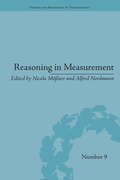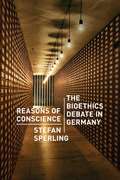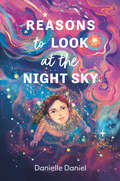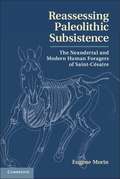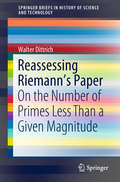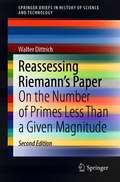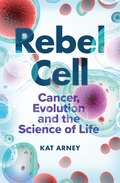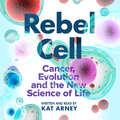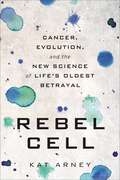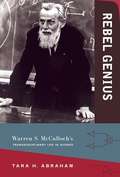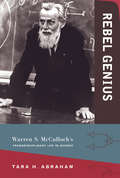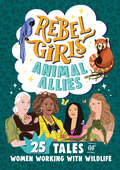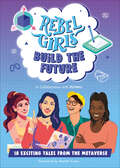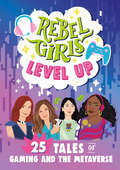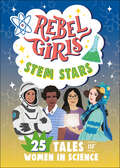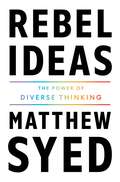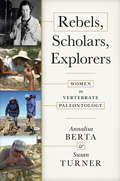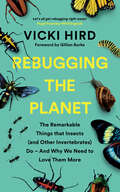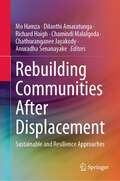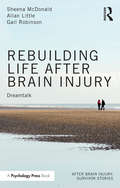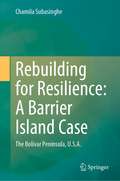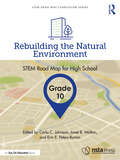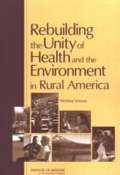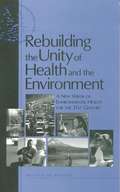- Table View
- List View
Reasoning in Measurement (History and Philosophy of Technoscience)
by Nicola Mößner and Alfred NordmannThis collection offers a new understanding of the epistemology of measurement. The interdisciplinary volume explores how measurements are produced, for example, in astronomy and seismology, in studies of human sexuality and ecology, in brain imaging and intelligence testing. It considers photography as a measurement technology and Henry David Thoreau's poetic measures as closing the gap between mind and world. By focusing on measurements as the hard-won results of conceptual as well as technical operations, the authors of the book no longer presuppose that measurement is always and exclusively a means of representing some feature of a target object or entity. Measurement also provides knowledge about the degree to which things have been standardized or harmonized – it is an indicator of how closely human practices are attuned to each other and the world.
Reasons of Conscience: The Bioethics Debate in Germany
by Stefan SperlingThe implicit questions that inevitably underlie German bioethics are the same ones that have pervaded all of German public life for decades: How could the Holocaust have happened? And how can Germans make sure that it will never happen again? In "Reasons of Conscience," Stefan Sperling considers the bioethical debates surrounding embryonic stem cell research in Germany at the turn of the twenty-first century, highlighting how the countryOCOs ongoing struggle to come to terms with its past informs the decisions it makes today. aaaaaaaaaaaSperling brings the reader unmatched access to the offices of the German parliament to convey the role that morality and ethics play in contemporary Germany. He describes the separate and interactive workings of the two bodies assigned to shape German bioethicsOCothe parliamentary Enquiry Commission on Law and Ethics in Modern Medicine and the executive branchOCOs National Ethics CouncilOCotracing each institutionOCOs genesis, projected image, and operations, and revealing that the content of bioethics cannot be separated from the workings of these institutions. Sperling then focuses his discussion around three core categoriesOCotransparency, conscience, and Germany itselfOCoarguing that without fully considering these, we fail to understand German bioethics. He concludes with an assessment of German legislators and regulatorsOCO attempts to incorporate criteria of ethical research into the German Stem Cell Law. "
Reasons to Look at the Night Sky
by Danielle DanielA sensitive middle grade novel in verse about a space-obsessed girl who dreams of becoming an astronaut — and begins to see the world differently when a substitute teacher enters her orbit.Luna has always loved the night sky. She's an eleven-year-old who knows everything there is to know about space, and dreams of one day becoming an astronaut. The first step in her plan to get there is to ace the space unit in her science class and secure a spot in NASA's summer space camp.But when Luna's teacher is unexpectedly replaced with a substitute, Ms. Manitowabi, who is looking to shake up science class by bringing in art, Luna's carefully laid plans are crushed. And that's not all that's shifting in Luna's life — changes at home and in her friendships have her feeling topsy-turvy. What on Planet Earth is happening? Reasons to Look at the Night Sky is an endearing, poetic look at the inner world of a middle schooler grappling with change from acclaimed author and illustrator Danielle Daniel.
Reassessing Paleolithic Subsistence: The Neandertal and Modern Human Foragers of Saint-Césaire
by Eugène MorinThe contribution of Neandertals to the biological and cultural emergence of early modern humans remains highly debated in anthropology. Particularly controversial is the long-held view that Neandertals in Western Europe were replaced 30,000 to 40,000 years ago by early modern humans expanding out of Africa. This book contributes to this debate by exploring the diets and foraging patterns of both Neandertals and early modern humans. Eugène Morin examines the faunal remains from Saint-Césaire in France, which contains an exceptionally long and detailed chronological sequence, as well as genetic, anatomical, and other archaeological evidence to shed new light on the problem of modern human origins.
Reassessing Riemann's Paper: On The Number Of Primes Less Than A Given Magnitude (Springerbriefs In History Of Science And Technology Ser.)
by Walter DittrichIn this book, the author pays tribute to Bernhard Riemann (1826–1866), mathematician with revolutionary ideas, whose work on the theory of integration, the Fourier transform, the hypergeometric differential equation, etc. contributed immensely to mathematical physics. This book concentrates in particular on Riemann’s only work on prime numbers, including such then new ideas as analytical continuation in the complex plane and the product formula for entire functions. A detailed analysis of the zeros of the Riemann zeta function is presented. The impact of Riemann’s ideas on regularizing infinite values in field theory is also emphasized.
Reassessing Riemann's Paper: On the Number of Primes Less Than a Given Magnitude (SpringerBriefs in History of Science and Technology)
by Walter DittrichIn this book, the author pays tribute to Bernhard Riemann (1826-1866), a mathematician with revolutionary ideas, whose work on the theory of integration, the Fourier transform, the hypergeometric differential equation, etc. contributed immensely to mathematical physics. The text concentrates in particular on Riemann’s only work on prime numbers, including ideas – new at the time – such as analytical continuation into the complex plane and the product formula for entire functions. A detailed analysis of the zeros of the Riemann zeta-function is presented. The impact of Riemann’s ideas on regularizing infinite values in field theory is also emphasized. This revised and enhanced new edition contains three new chapters, two on the application of Riemann’s zeta-function regularization to obtain the partition function of a Bose (Fermi) oscillator and one on the zeta-function regularization in quantum electrodynamics. Appendix A2 has been re-written to make the calculations more transparent. A summary of Euler-Riemann formulae completes the book.
Rebel Cell: Cancer, Evolution and the Science of Life
by Dr Kat Arney'A lively study of the Big C, which makes the case that cancer is the price we pay for our marvellously complicated bodies.' The Times, best books of 2020'This book is packed with big ideas about life. Every chapter has something in it which made me think wow. Having worked in a major cancer charity for many years, Arney writes with genuine in-depth understanding and is a perfect guide.' Daniel M. Davis, author of The Beautiful Cure'Rebel Cell is a bright, engaging read, fizzing with energy and metaphor. Kat Arney is a science writer for all of us - a powerful and talented story teller.' Stephen McGann'Kat's book is Dynamite. A crystal clear reappraisal of the story behind that word we fear to mention.' Dallas Campbell, author of Ad Astra: An Illustrated Guide to Leaving the PlanetCancer has always been with us. It killed our hominid ancestors, the mammals they evolved from and the dinosaurs that trampled the ground before that. Tumours grow in pets, livestock and wild animals. Even tiny jelly-like Hydra - creatures that are little more than a tube full of water - can get cancer. Paradoxically, many of us think of cancer as a contemporary killer, a disease of our own making caused by our modern lifestyles. But that's not true. Although it might be rare in many species, cancer is the enemy lurking within almost every living creature. Why? Because cancer is a bug in the system of life. We get cancer because we can't not get it.Cancer starts when cells revolt, throwing off their molecular shackles, and growing and dividing out of control in a shambolic mockery of normal life. This is why we can't avoid cancer: because the very genes that drive it are essential for life itself. The revolution has raged, on and off, for millions of years. But it was only in the twentieth century that doctors and scientists made any significant progress in understanding and treating cancer, and it's only in the past few decades that we've finally begun to kick the mob's malignant arse. Now the game is changing. Scientists have infiltrated cancer's cellular rebellion and are finally learning its secrets.Geneticist and science writer Kat Arney takes the reader back to the dawn of life on planet earth right up to the present day to get to the heart of what cancer really is and how by better understanding it we might one day overcome it.
Rebel Cell: Cancer, Evolution and the Science of Life
by Dr Kat Arney'A lively study of the Big C, which makes the case that cancer is the price we pay for our marvellously complicated bodies.' The Times, best books of 2020'This book is packed with big ideas about life. Every chapter has something in it which made me think wow. Having worked in a major cancer charity for many years, Arney writes with genuine in-depth understanding and is a perfect guide.' Daniel M. Davis, author of The Beautiful Cure'Rebel Cell is a bright, engaging read, fizzing with energy and metaphor. Kat Arney is a science writer for all of us - a powerful and talented story teller.' Stephen McGann'Kat's book is Dynamite. A crystal clear reappraisal of the story behind that word we fear to mention.' Dallas Campbell, author of Ad Astra: An Illustrated Guide to Leaving the PlanetCancer has always been with us. It killed our hominid ancestors, the mammals they evolved from and the dinosaurs that trampled the ground before that. Tumours grow in pets, livestock and wild animals. Even tiny jelly-like Hydra - creatures that are little more than a tube full of water - can get cancer. Paradoxically, many of us think of cancer as a contemporary killer, a disease of our own making caused by our modern lifestyles. But that's not true. Although it might be rare in many species, cancer is the enemy lurking within almost every living creature. Why? Because cancer is a bug in the system of life. We get cancer because we can't not get it.Cancer starts when cells revolt, throwing off their molecular shackles, and growing and dividing out of control in a shambolic mockery of normal life. This is why we can't avoid cancer: because the very genes that drive it are essential for life itself. The revolution has raged, on and off, for millions of years. But it was only in the twentieth century that doctors and scientists made any significant progress in understanding and treating cancer, and it's only in the past few decades that we've finally begun to kick the mob's malignant arse. Now the game is changing. Scientists have infiltrated cancer's cellular rebellion and are finally learning its secrets.Geneticist and science writer Kat Arney takes the reader back to the dawn of life on planet earth right up to the present day to get to the heart of what cancer really is and how by better understanding it we might one day overcome it.
Rebel Cell: Cancer, Evolution, and the New Science of Life's Oldest Betrayal
by Kat ArneyWhy do we get cancer? Is it our modern diets and unhealthy habits? Chemicals in the environment? An unwelcome genetic inheritance? Or is it just bad luck? The answer is all of these and none of them. We get cancer because we can't avoid it—it's a bug in the system of life itself. Cancer exists in nearly every animal and has afflicted humans as long as our species has walked the earth. In Rebel Cell: Cancer, Evolution, and the New Science of Life's Oldest Betrayal, Kat Arney reveals the secrets of our most formidable medical enemy, most notably the fact that it isn't so much a foreign invader as a double agent: cancer is hardwired into the fundamental processes of life. New evidence shows that this disease is the result of the same evolutionary changes that allowed us to thrive. Evolution helped us outsmart our environment, and it helps cancer outsmart its environment as well—alas, that environment is us. Explaining why "everything we know about cancer is wrong," Arney, a geneticist and award-winning science writer, guides readers with her trademark wit and clarity through the latest research into the cellular mavericks that rebel against the rigid biological "society" of the body and make a leap towards anarchy. We need to be a lot smarter to defeat such a wily foe—smarter even than Darwin himself. In this new world, where we know that every cancer is unique and can evolve its way out of trouble, the old models of treatment have reached their limits. But we are starting to decipher cancer's secret evolutionary playbook, mapping the landscapes in which these rogue cells survive, thrive, or die, and using this knowledge to predict and confound cancer's next move. Rebel Cell is a story about life and death, hope and hubris, nature and nurture. It's about a new way of thinking about what this disease really is and the role it plays in human life. Above all, it's a story about where cancer came from, where it's going, and how we can stop it.
Rebel Genius: Warren S. McCulloch's Transdisciplinary Life in Science
by Tara AbrahamWarren S. McCulloch (1898--1969) adopted many identities in his scientific life -- among them philosopher, poet, neurologist, neurophysiologist, neuropsychiatrist, collaborator, theorist, cybernetician, mentor, engineer. He was, writes Tara Abraham in this account of McCulloch's life and work, "an intellectual showman," and performed this part throughout his career. While McCulloch claimed a common thread in his work was the problem of mind and its relationship to the brain, there was much more to him than that. In Rebel Genius, Abraham uses McCulloch's life as a window on a past scientific age, showing the complex transformations that took place in American brain and mind science in the twentieth century -- particularly those surrounding the cybernetics movement.Abraham describes McCulloch's early work in neuropsychiatry, and his emerging identity as a neurophysiologist. She explores his transformative years at the Illinois Neuropsychiatric Institute and his work with Walter Pitts -- often seen as the first iteration of "artificial intelligence" but here described as stemming from the new tradition of mathematical treatments of biological problems. Abraham argues that McCulloch's dual identities as neuropsychiatrist and cybernetician are inseparable. He used the authority he gained in traditional disciplinary roles as a basis for posing big questions about the brain and mind as a cybernetician. When McCulloch moved to the Research Laboratory of Electronics at MIT, new practices for studying the brain, grounded in mathematics, philosophy, and theoretical modeling, expanded the relevance and ramifications of his work. McCulloch's transdisciplinary legacies anticipated today's multidisciplinary field of cognitive science.
Rebel Genius: Warren S. McCulloch's Transdisciplinary Life in Science (The\mit Press Ser.)
by Tara AbrahamThe life and work of a scientist who spent his career crossing disciplinary boundaries—from experimental neurology to psychiatry to cybernetics to engineering.Warren S. McCulloch (1898–1969) adopted many identities in his scientific life—among them philosopher, poet, neurologist, neurophysiologist, neuropsychiatrist, collaborator, theorist, cybernetician, mentor, engineer. He was, writes Tara Abraham in this account of McCulloch's life and work, “an intellectual showman,” and performed this part throughout his career. While McCulloch claimed a common thread in his work was the problem of mind and its relationship to the brain, there was much more to him than that. In Rebel Genius, Abraham uses McCulloch's life as a window on a past scientific age, showing the complex transformations that took place in American brain and mind science in the twentieth century—particularly those surrounding the cybernetics movement.Abraham describes McCulloch's early work in neuropsychiatry, and his emerging identity as a neurophysiologist. She explores his transformative years at the Illinois Neuropsychiatric Institute and his work with Walter Pitts—often seen as the first iteration of “artificial intelligence” but here described as stemming from the new tradition of mathematical treatments of biological problems. Abraham argues that McCulloch's dual identities as neuropsychiatrist and cybernetician are inseparable. He used the authority he gained in traditional disciplinary roles as a basis for posing big questions about the brain and mind as a cybernetician. When McCulloch moved to the Research Laboratory of Electronics at MIT, new practices for studying the brain, grounded in mathematics, philosophy, and theoretical modeling, expanded the relevance and ramifications of his work. McCulloch's transdisciplinary legacies anticipated today's multidisciplinary field of cognitive science.
Rebel Girls Animal Allies: 25 Tales of Women Working with Wildlife (Rebel Girls Minis)
by Lucy King Rebel GirlsTRUE STORIES OF ANIMAL ADVOCATESMeet 25 brave, compassionate scientists, veterinarians, activists, and others who fight for animal rights and conservation. Animal Allies takes readers all around the world—to the tops of trees and the bottom of oceans, deep into the jungle and high into the mountains.Swim with the sharks alongside Eugenie Clark, build bat houses with Amanda Lear, nurse a baby hippo to health with Christina Gorsuch, and protect endangered seahorses with Amanda Vincent and Heather Koldewey.With a foreword by zoologist Lucy King and activities curated by conservationist Bindi Irwin, this book is sure to inspire animal lovers everywhere. Plus, scannable codes let you listen to longer stories on the Rebel Girls App!
Rebel Girls Build the Future: Terrific Tales From The Metaverse
by Rebel GirlsThis co-branded book features 18 stories of women on the cutting-edge of virtual reality and technology: women who are building the Metaverse. It showcases some of the exciting ways girls can engage with this new world of tech, from game design and 3D art to data science and software engineering.The book includes engaging activities to explore tech, art, and imagination, and a foreword from Rachel Cross, the leader of Reality Labs. It will inspire the next generation to consider creative careers in tech, art, computer programming, and design—and be at the forefront of what’s to come. Rebel Girls Build the Future will release in November ahead of National STEM Day.
Rebel Girls Level Up: 25 Tales of Gaming and the Metaverse (Rebel Girls Minis)
by Rebel GirlsTRUE STORIES OF CREATORS AND COMMUNITY!Meet 25 inspiring women in the world of gaming and the metaverse. Read about how they&’ve created innovative technology, designed the video games you play, and broken barriers whenever their industry put up walls.Dive into gamer communities with popular streamers like Imane Anys, better known as Pokimane. Learn to lead with Aya Kyogoku, who directed several Animal Crossing games. Design digital clothing with Roblox creators like cSapphire. And compete in the wild world of esports with pro gamers Sasha Hostyn and Sylvia Gathoni.This book pairs inspiring, easy-to-read text with colorful full-page portraits created by female and nonbinary artists from all around the world. Plus, scannable codes let you listen to longer stories on the Rebel Girls app!
Rebel Girls STEM Stars: 25 Tales of Women in Science (Rebel Girls Minis)
by Rebel GirlsTRUE STORIES OF DETERMINATION AND DISCOVERYThis collection of short stories about trailblazing women in STEM features 25 inspiring tales of professionals in science, technology, engineering, and math. Read about how these women solved problems, made incredible breakthroughs, and paved the way for future scientists everywhere.Create a computer with mathematician Ada Lovelace. Design a robot with engineer Cynthia Breazeal. And help others with Rebecca Lee Crumpler, the first African American woman to become a doctor of medicine.The latest book in the Rebel Girls Minis series features:Inspirational female role models – an anthology of barrier-breaking women in science and technology, with stories to inspire young readers to greatness in their own livesInsight into real-world careers – accessible introductions to real-world professions that encourage young girls to embrace curiosity, develop problem-solving skills, and explore new interestsDiverse fields and women – a wide range of scientific fields, from computer programming to robotics, with women’s stories encompassing a range of time periods, countries, and abilitiesRebel Girls STEM Stars pairs inspiring, easy-to-read text with colorful, full-page portraits created by female and nonbinary artists from around the world. Plus, readers can scan QR codes inside that let you listen to longer stories on the Rebel Girls app!
Rebel Ideas: The Power of Diverse Thinking
by Matthew SyedIdeas are everywhere, but those with the greatest problem-solving, business-transforming, and life-changing potential are often hard to identify. Even when we recognize good ideas, applying them to everyday obstacles—whether in the workplace, our homes, or our civic institutions—can seem insurmountable. According to Matthew Syed, it doesn't have to be this way. In Rebel Ideas, Syed argues that our brainpower as individuals isn't enough. To tackle problems from climate change to economic decline, we'll need to employ the power of "cognitive diversity." Drawing on psychology, genetics, and beyond, Syed uses real-world scenarios including the failings of the CIA before 9/11 and a communication disaster at the peak of Mount Everest to introduce us to the true power of thinking differently. Rebel Ideas will strengthen any kind of team, while including advice on how, as individuals, we can embrace the potential of an "outsider mind-set" as our greatest asset. Matthew Syed is the Sunday Times bestselling author of Black Box Thinking, Bounce, and The Greatest. He writes an award-winning newspaper column in The Times and is the host of the hugely successful BBC podcast Flintoff, Savage and the Ping Pong Guy.
Rebels, Scholars, Explorers: Women in Vertebrate Paleontology
by Annalisa Berta Susan TurnerUnearthing the amazing hidden stories of women who changed paleontology forever.For centuries, women have played key roles in defining and developing the field of vertebrate paleontology. Yet very little is known about these important paleontologists, and the true impacts of their contributions have remained obscure. In Rebels, Scholars, Explorers, Annalisa Berta and Susan Turner celebrate the history of women "bone hunters," delving into their fascinating lives and work. At the same time, they explore how the discipline has shaped our understanding of the history of life on Earth.Berta and Turner begin by presenting readers with a review of the emergence of vertebrate paleontology as a science, emphasizing the contributions of women to research topics and employment. This is followed by brief biographical sketches and explanations of early discoveries by women around the world over the past 200 years, including those who who held roles as researchers, educators, curators, artists, and preparators. Forging new territory, Berta and Turner highlight the barriers and challenges faced by women paleontologists, describing how some managed to overcome those obstacles in order to build careers in the field. Finally, drawing on interviews with a diverse group of contemporary paleontologists, who share their experiences and offer recommendations to aspiring fossil hunters, they provide perspectives on what work still needs to be done in order to ensure that women's contributions to the field are encouraged and celebrated. Uncovering and relating lost stories about the pivotal contributions of women in vertebrate paleontology doesn't just make for enthralling storytelling, but also helps ensure a richer and more diverse future for this vibrant field. Illuminating the discoveries, collections, and studies of fossil vertebrates conducted by women in vertebrate paleontology, Rebels, Scholars, Explorers will be on every paleontologist's most-wanted list and should find a broader audience in the burgeoning sector of readers from all backgrounds eager to learn about women in the sciences.
Reborn (Altered #3)
by Jennifer RushThe Branch is in shambles, but Anna, Sam, Cas, and Nick can't rest easy. Remnants of the organization lurk unseen and the flashbacks to their old lives are only getting stronger--especially Nick's.Following scattered memories and clues from his Branch file, Nick sets off alone in search of answers and in search of the girl who haunts his dreams. But the sleepy town where she lives in full of secrets and Nick soon learns that uncovering their shared past may have deadly consequences.
Rebugging the Planet: The Remarkable Things that Insects (and Other Invertebrates) Do – And Why We Need to Love Them More
by Vicki Hird"This is a lovely little book that could and should have a big impact...Let’s all get rebugging right away!"—Hugh Fearnley-Whittingstall Meet the intelligent insects, marvelous minibeasts, and inspirational invertebrates that help shape our planet—and discover how you can help them help us by rebugging your attitude today! Remember when there were bugs on your windshield? Ever wonder where they went? We need to act now if we are to help the insects survive. Robin Wall Kimmerer, David Attenborough, and Elizabeth Kolbert are but a few voices championing the rewilding of our world. Rebugging the Planet explains how we are headed toward “insectageddon” with a rate of insect extinction eight times faster than that of mammals or birds, and gives us crucial information to help all those essential creepy-crawlies flourish once more. Author Vicki Hird passionately demonstrates how insects and invertebrates are the cornerstone of our global ecosystem. They pollinate plants, feed birds, support and defend our food crops, and clean our water systems. They are also beautiful, inventive, and economically invaluable—bees, for example, contribute an estimated $235 to $577 billion to the US economy annually, according to Forbes. Rebugging the Planet shows us small changes we can make to have a big impact on our littlest allies: Learn how to rewild parks, schools, sidewalks, roadsides, and other green spaces. Leave your garden to grow a little wild and plant weedkiller-free, wildlife-friendly plants. Take your kids on a minibeast treasure hunt and learn how to build bug palaces. Make bug-friendly choices with your food and support good farming practices Begin to understand how reducing inequality and poverty will help nature and wildlife too—it’s all connected. So do your part and start rebugging today! The bees, ants, earthworms, butterflies, beetles, grasshoppers, ladybugs, snails, and slugs will thank you—and our planet will thank you too.
Rebuilding Communities After Displacement: Sustainable and Resilience Approaches
by Dilanthi Amaratunga Richard Haigh Mo Hamza Chamindi Malalgoda Chathuranganee Jayakody Anuradha SenanayakeThis book presents a collection of double-blind peer reviewed papers under the scope of sustainable and resilient approaches for rebuilding displaced and host communities. Forced displacement is a major development challenge, not only a humanitarian concern. A surge in violent conflict, as well as increasing levels of disaster risk and environmental degradation driven by climate change, has forced people to leave or flee their homes – both internally displaced as well as refugees. The rate of forced displacement befalling in different countries all over the world today is phenomenal, with an increasingly higher rate of the population being affected on daily basis than ever. These displacement situations are becoming increasingly protracted, many lasting over 5 years. Therefore, there is a need to develop more sustainable and resilient approaches to rebuild these displaced communities ensuring the long-term satisfaction of communities and enhancing the social cohesion between the displaced and host communities. Accordingly, chapters are arranged around five main themes of rebuilding communities after displacement.Response management for displaced communitiesThe Built environment in resettlement planningGovernance of displacementSocio-Economic interventions for sustainable resettlement
Rebuilding Life after Brain Injury: Dreamtalk (After Brain Injury: Survivor Stories)
by Allan Little Sheena McDonald Gail RobinsonRebuilding Life after Brain Injury: Dreamtalk tells the survival story of Sheena McDonald, who in 1999 was hit by a police van and suffered a very severe brain injury. Sheena’s story is told from her own, personal standpoint and also from two further unique and invaluable perspectives. Allan Little, a BBC journalist and now Sheena’s husband, describes both the physical and mental impact of the injury on himself and on Sheena. Gail Robinson, Sheena’s neuropsychological rehabilitation specialist, provides professional commentaries on Sheena’s condition, assessment and recovery process. The word Dreamtalk, created by Allan to describe Sheena’s once "hallucinogenic state", sets the tone for this book. It humanises and contextualises the impact of brain injury, providing support and encouragement for patients, professionals and families. It presents exclusive insights into each stage of recovery, spanning coma, altered consciousness, post-traumatic amnesia and rehabilitation; all showing how she has defied conventional clinical expectations and made an exceptional recovery. This book is valuable reading to those who have suffered a brain injury and also to professionals such as neurologists, neuropsychologists, physiotherapists, occupational therapists and speech therapists working in the field.
Rebuilding for Resilience: The Bolivar Peninsula, U.S.A.
by Chamila SubasingheRecurring extreme events of nature challenge disaster-prone settlements in complex ways. Devastating property damages are one of the tests of survival for such settlements in both economic and social terms. It also provides unique opportunities to rethink the environment cleared by massive natural disasters. However, rebuilding for long-term resiliency is one of the least investigated areas, particularly when employing tacit knowledge in the sustainable recovery process. This book builds a discursive field around the post-disaster rebuilding of Bolivar Peninsula aftermath Hurricane Ike to demonstrate reciprocity between disaster absorptive ecological formations such as barrier islands and their exploitative human occupation. In the process, it investigates the nexus between connectivity among open space networks to various levels of surge damage among Bolivar spontaneous settlements. Beyond scientific analyses, the Hurricane Ike study triangulates syntactical methods with structured observations and statistical analyses to offer a holistic reporting model for emerging scholars and independent investigators, which one may find quite absent in the mainstream disaster studies and journalism.
Rebuilding the Natural Environment, Grade 10: STEM Road Map for High School (STEM Road Map Curriculum Series)
by Carla C. Johnson Erin E. Peters-Burton Janet B. WaltonWhat if you could challenge your tenth graders to think about how innovation can make the world a better place for humans, while finding ways to sustain progress and conserve resources? With this volume in the STEM Road Map Curriculum Series, you can! Rebuilding the Natural Environment outlines a journey that will steer your students toward authentic problem solving while grounding them in integrated STEM disciplines. Like the other volumes in the series, this book is designed to meet the growing need to infuse real-world learning into K–12 classrooms. This interdisciplinary, four-lesson module uses project- and problem-based learning to help students connect their existing knowledge about energy production and its effects on the natural environment to create innovations in renewable sources of energy based on research evidence. Working in teams, students will design an innovative way to meet society’s energy needs and develop a pitch to market their innovation, focusing on how the innovation will optimize human experiences while being mindful of the natural environment. To support this goal, students will do the following: • Understand several forms of renewable, sustainable energy sources. • Apply their understanding of how alternators are used to generate electricity in lab experiments, as well as explain how tools such as windmills and dams are used to operate them. • Describe how electricity is generated in photovoltaic cells. • Calculate the amount of electricity consumed by several household items and consider this consumption when determining the average monthly energy consumption of households around the world in comparison to U.S. households. • Understand how fossil fuels have been used in the production of electricity and the impact they have had on the world’s economy, humans’ quality of life, and the earth. • Identify several hindrances to the creation of new energy sources as well as ideas to counter them. • List several factors that can be used to motivate people from all walks of life to use renewable and sustainable energies. • Create a fictional company that uses renewable energies. The STEM Road Map Curriculum Series is anchored in the Next Generation Science Standards, the Common Core State Standards, and the Framework for 21st Century Learning. In-depth and flexible, Rebuilding the Natural Environment can be used as a whole unit or in part to meet the needs of districts, schools, and teachers who are charting a course toward an integrated STEM approach.
Rebuilding the Unity of Health and the Environment in Rural America: Workshop Summary
by Institute of Medicine of the National AcademiesThe National Academies Press (NAP)--publisher for the National Academies--publishes more than 200 books a year offering the most authoritative views, definitive information, and groundbreaking recommendations on a wide range of topics in science, engineering, and health. Our books are unique in that they are authored by the nation's leading experts in every scientific field.
Rebuilding the Unity of Health and the Environment: A NEW VISION OF ENVIRONMENTAL HEALTH FOR THE 21ST CENTURY
by Kathi Hanna Christine CoussensInformation on Rebuilding the Unity of Health and the Environment
